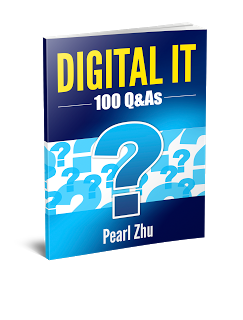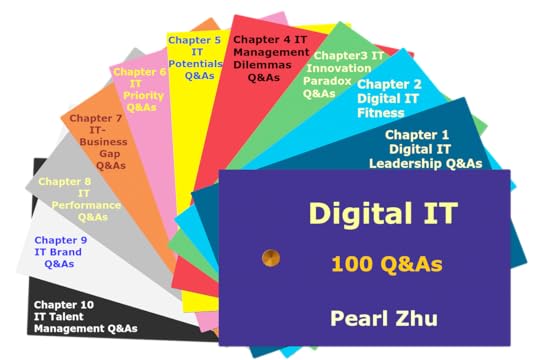Pearl Zhu's Blog, page 1237
April 11, 2017
The New Book "Digital IT: 100 Q&As" Book Introduction

Nowadays information is the lifeblood, and the emergent technology is more often the business disruptor. Due to the changing nature of information and technology, IT is always in the changing environment creating unexpected situations and requiring quick and appropriate responses based on the conditions. IT is at the crossroad due to the exponential growth of information and disruptive nature of digital technologies. It is the time to reimagine IT via inspiring critical and creative thinking and spurring healthy debating. The healthy debates, in fact, help the business and IT do more reflection via pondering deeper and understanding things from multidimensional angles. Because debating is a type of critical thinking activity. Critical thinking is a basic form of organized thought specifically used to frame the right questions, identify the real problems, and discover better ways to do things.
From IT management and innovation perspective, there’re quite a few classic IT debates last decades-long and emergent digital debates rise on the horizon: Does IT still matter? What will happen to the CIO role? What is the nature of the digital IT leadership and what is the primary role of the CIO in harnessing the IT leadership? What is IT role in your company? What is the real business value of IT? Is IT a cost center or value creator? Business vs IT: Where do you stand for? Is IT/business siloing a chronic problem in many organizations? When should IT lead, when should IT follow? How will IT have to change? Are you there to just keep the lights on, or is IT expected to actively take part in strategic and tactical decisions? In essence, are you focused on projects or infrastructure? What kind of people should be working in your IT group? Do you want techies, business gurus, project-oriented people? What rough percentage of each? How is IT performance as an organization evaluated by the rest of the company? How will you measure success., etc.
 The purpose of “Digital IT-100 Q&As “ is to summarize 100+ classic and emergent digital debates about digital IT leadership and management, brainstorm how to run a holistic digital business from multidimensional lens, share digital holism and strategic insight, keep IT digital fit, deal with both IT management dilemmas and innovation paradoxes effortlessly, guide today’s digital leaders and professionals to learn the valuable lessons across industrial and geographical boundaries, develop the best and next digital practices to tailor their needs, set the right priorities to achieve high performance, and build a solid digital brand, with the goal to accelerate digital transformation.
The purpose of “Digital IT-100 Q&As “ is to summarize 100+ classic and emergent digital debates about digital IT leadership and management, brainstorm how to run a holistic digital business from multidimensional lens, share digital holism and strategic insight, keep IT digital fit, deal with both IT management dilemmas and innovation paradoxes effortlessly, guide today’s digital leaders and professionals to learn the valuable lessons across industrial and geographical boundaries, develop the best and next digital practices to tailor their needs, set the right priorities to achieve high performance, and build a solid digital brand, with the goal to accelerate digital transformation.Chapter 1 Digital IT Leadership Q&A: Due to the abundance of information and omnipresence of technologies, IT plays a pivotal role in the business’s digital transformation journey. Therefore, digital CIOs have to wear multiple hats and play different roles in the information-abundant organizations today. Nowadays, the CIO is not just leveraging IT to keep the lights on, but managing information to ensure the right people getting the right information at the right time to make the right decisions; and it takes the visionary leadership for orchestrating digital transformation journey smoothly.
Chapter 2 Digital IT Fitness Q&As: The term 'fit' can be interpreted with a degree of variability: Where you want to look for 'fit' is in relation to the growth mindset and values you want to build or maintain within your team, and the kinds of behaviors that you would expect to see as a result of, or in alignment with those values. 'Fit' doesn't mean that everyone needs to have the same thought processes, the same personalities, the same preferences, or the same experiences. What is important is that everyone feels committed to the goals of the team, and are comfortable to bring fresh perspectives with the behavioral expectations associated with those goals.
Chapter 3 Digital IT Innovation Paradox Q&As: Innovation is the light every forward-looking organization is pursuing. However, for most businesses, innovation is still serendipitous, not so many people like innovation, because innovation stands for risk, and that associated with trouble, Innovation management has an overall very low success rate. It is crucial to examine the causes of failure in innovation, the gaps, and pitfalls on the way, to spur healthy debates about innovation paradox. The objective is to raise awareness of what’s needed to improve the probability of innovation success and make the innovation journey more delightful.
Chapter 4 Digital IT Management Dilemmas: Technology is pervasive, business initiatives, changes, and transformation today nearly always involve some form of technology implementation or information analysis; IT touches both hard business processes and soft human behaviors. However, managing a highly effective IT is not an easy job, IT leaders have to overcome many change management roadblocks and deal with quite a few of IT management dilemmas in transforming from a cost center to value creator, from a support desk to a strategic business partner; and from a back office function to an innovation brain yard.
Chapter 5 Digital IT Potential Q&As: Traditional IT organizations are perceived as the cost center, running in an inside-out operation driven mode. Nowadays, with the exponential growth of information and lightweight digital technologies, forward-looking organizations across industrial sectors claim they are in the information management business, and there is a high expectation of IT to drive changes and lead the digital transformation. Therefore, the invisible divide IT vs. business needs to go away, and CIOs should market themselves and advocate IT as an integrated component -the business backbone or the digital brain of the company, in order to unleash the full potential of digital IT, and run IT as an innovation engine and revenue generator for the business.
Chapter 6 Digital IT Priority Q&As: Modern businesses can often get trapped into "busyness," overwhelmed with too many projects or change initiatives, and overloaded with the operation and short-term business concerns. Prioritization starts with a right mindset -first of all, corporate leaders have to craft an executable strategy, a good strategy can map business goals with employee goals systematically, laser focus on the most critical challenge the business needs to overcome, and also engage employees by co-setting their work goals which are stretch out, but not too stressful. A high performing business can manage both their talent and resource effectively via prioritization and optimization.
Chapter 7 IT-Business Gap Q&As: The very characteristic of the digital era is hyperconnectivity. On one hand, digital technology trends such as IT consumerization shrink the IT-business gap; however, the collective mindsets, cultures, and accelerated change gaps between business and technology are not shrinking, because each part of the business evolves digital transformation with the different speed. In fact, bridging the gap between IT and the business is the issue of all about change. It is important to integrate the steps, processes, tools and products that organizations use to effect the transformation from strategy to deployment.
Chapter 8 Digital IT Performance Q&As: IT metrics need to evolve to something that matters to the business audience, at the same time that "business sentiment" needs to get put into something more tangible. Selecting the right key performance indicator is one of the most important steps in measurement because this process includes to answering why you are choosing that, how you will use them and whether you have enough resources to manage data. Always attempt to identify areas in which measurable improvements can be realized, providing demonstrable value is essential, in some instances, these areas have been low-hanging fruit. Your measures should cover all areas that contribute to value creation including service quality, employee engagement, customer satisfaction, innovation benefit, and financial outcomes.
Chapter 9 IT Branding Q&As: A high-performing, high-reliable and high-proactive IT is the key success factor for the digital transformation of the business. IT branding needs to be part of IT transformation effort. With the rate of change is accelerated, it’s very important for the IT organizations to continually do “self-reflection’ upon the business effectiveness, process efficiency, strength and risks, culture, and brand etc. IT is a critical component of the business, commonly IT self-evaluation ability is a reflection on overall business culture within the whole organization. Take a critical look at IT, you need to be honest with yourself about assessing the strengths and weaknesses of IT organization, in order to build a solid IT brand.
Chapter 10: Digital IT Talent Management Q&As: Due to the evolutionary nature of technology and accelerating speed of business changes, one of the most pervasive and persistent concerns or complaints from IT leaders is the skills gap, such as, their people do not have the right competencies; they can’t find the right skills to fill the positions or their non-IT partners do not understand IT, etc. People are always the most invaluable asset to the organization but often turn to be the weakest link in strategy execution. Unlike the other tangible value of business assets which are more easily measured in a quantitative way, the true value of people, especially today’s high professional knowledge workforces include many tangible and intangible factors. Because people are not just the cost or the resource to be managed, but the capital to be invested in and their potential if unleashed can bring the quantum leap in the business growth.
Many think we are still living in the era in which the businesses and societies are information-rich and insight poor. The real critical thinking and healthy debate and argument are missing from businesses and society as a whole. In reality, we all bring our own biases and judgments to arguments. Having a debate where people are forced to uphold a view or belief that isn't necessarily their own, enforces critical thinking principles - looking at another belief from a little less emotional perspective, with increased perspective and less prejudgement. Critical thinking is asking questions and debating answers from all perspectives. The more salient points of the "ongoing debates," are to brainstorm the better way to do things and run a high mature digital IT organization. Whether it is a debate, argument, interview, investigation or chess game, critical thinking will apply. The debate, when used properly, can be a way to explore critical thinking from a non-biased perspective, re-examine the root causes of IT ineffectiveness, reimagine the digital potential of IT, and reinvent IT as a digital business engine. Critical Thinking plus healthy debating streamline IT leadership journey from good to great, from “command and control” to innovativeness. The digital leaders today would keep everyone involved and foster an environment of creative thinking and critical thinking, spur healthy debates for innovation, and make a leap of digital transformation.Follow us at: @Pearl_Zhu
Published on April 11, 2017 21:41
April 10, 2017
The Monthly CIO Debates Collection: The Strategic Conversation between CIOs and Other CxOs Apr., 2017
Debating is not for stimulating conflicts, but for brainstorming better ways to do things.
[image error] Modern CIOs face many challenges, it is not sufficient to only keep the lights on. Regardless of which industry or the nature of organization you are in, being a digital leader will need to master the art of creating unique, differentiating value from piles of commoditized technologies and take advantage of the emergent digital trends as well. Digital CIOs need to have multiple personas, “Chief Innovation Officer,” “Chief Insight Officer,” “Chief Improvement Officer,” “Chief Information Officer,” and here, we discuss CIOs as “Chief Inquisitive Officer,” with a set of Q&As to lead the digital transformation.
The Strategic Conversation between CIOs and Other CxOs
CIO as Chief Interaction Officer: What are the Strategic Conversation between CIO and Other CXOs all About? IT is no longer running as an isolated function or back office utility, nowadays, IT has to add more business value and delight both internal and end customers. Hence, CIO needs to talk about business with other C-Level more often, but not about IT. This is the major issue in companies. IT is a way to innovate business and improve processes, but it's not the solution if CIO doesn't understand business areas. CIOs must be adding value to the business and it is essential in decisions businesses ever make. However, as CIOs, how should you interpret IT aspects as business issues to the CXOs? How do you avoid the details of any IT decision and still convince the CXO it is the good strategy to make or best action to take?
CIO as Chief Interaction Officer: How to Communicate with Board & Executive Peers Effectively? CIOs play a significant leadership role to convey the technological vision and interact with internal business executives or boards. In order to bridge the gap between business talks and IT talks, they are responsible for making sure that the IT meets the business requirements and works as an enabler. But what are the most effective way for CIOs to communicate: Board presentation, governance meeting; IT briefing, portal or informal discussion?
How to Build Trust Business Relationships Modern CIOs have many titles, from ‘Chief Innovation Officer’ to ‘Chief Influence Officer’; from ‘Chief Insight Officer’ to ‘Chief Improvement Officer’, etc, but keep in mind CIOs also need to become ‘Chief Interaction Officer’ to build solid business relationship, because nowadays, IT touches every key process of business and every digital point of customer experience. CIO as Communicator: What's your CFO-Friendly Approaches? According to industry survey among both IT and financial decision makers, there's an information gap between CFO and CIO that burdens the relationship. There's been a lot said about the CFOs role as limiting factor for IT impact on the business. Therefore, transparency and speaking the same language is an important start. As CIO, how do you discuss IT strategy and vision with the CFO? How to make the inevitable IT budget "negotiation" easier?
 Five Styles of Conversation Modern CIO need Master ForThe “Future of CIO” Blog has reached 1.8 million page views with 3600+ blog posting in 59+ different categories of leadership, management, strategy, digitalization, change/talent, etc. blog posting. The content richness is not for its own sake, but to convey the vision and share the wisdom. Blogging is not about writing, but about thinking and innovating the new ideas; it’s not just about WHAT to say, but about WHY to say, and HOW to say it. It reflects the color and shade of your thought patterns, and it indicates the peaks and curves of your thinking waves. Unlike pure entertainment, quality and professional content takes time for digesting, contemplation and engaging, and therefore, it takes time to attract the "hungry minds" and the "deep souls." It’s the journey to amplify diverse voices and deepen digital footprints, and it's the way to harness your innovative spirit.
Five Styles of Conversation Modern CIO need Master ForThe “Future of CIO” Blog has reached 1.8 million page views with 3600+ blog posting in 59+ different categories of leadership, management, strategy, digitalization, change/talent, etc. blog posting. The content richness is not for its own sake, but to convey the vision and share the wisdom. Blogging is not about writing, but about thinking and innovating the new ideas; it’s not just about WHAT to say, but about WHY to say, and HOW to say it. It reflects the color and shade of your thought patterns, and it indicates the peaks and curves of your thinking waves. Unlike pure entertainment, quality and professional content takes time for digesting, contemplation and engaging, and therefore, it takes time to attract the "hungry minds" and the "deep souls." It’s the journey to amplify diverse voices and deepen digital footprints, and it's the way to harness your innovative spirit.
Follow us at: @Pearl_Zhu
[image error] Modern CIOs face many challenges, it is not sufficient to only keep the lights on. Regardless of which industry or the nature of organization you are in, being a digital leader will need to master the art of creating unique, differentiating value from piles of commoditized technologies and take advantage of the emergent digital trends as well. Digital CIOs need to have multiple personas, “Chief Innovation Officer,” “Chief Insight Officer,” “Chief Improvement Officer,” “Chief Information Officer,” and here, we discuss CIOs as “Chief Inquisitive Officer,” with a set of Q&As to lead the digital transformation.
The Strategic Conversation between CIOs and Other CxOs
CIO as Chief Interaction Officer: What are the Strategic Conversation between CIO and Other CXOs all About? IT is no longer running as an isolated function or back office utility, nowadays, IT has to add more business value and delight both internal and end customers. Hence, CIO needs to talk about business with other C-Level more often, but not about IT. This is the major issue in companies. IT is a way to innovate business and improve processes, but it's not the solution if CIO doesn't understand business areas. CIOs must be adding value to the business and it is essential in decisions businesses ever make. However, as CIOs, how should you interpret IT aspects as business issues to the CXOs? How do you avoid the details of any IT decision and still convince the CXO it is the good strategy to make or best action to take?
CIO as Chief Interaction Officer: How to Communicate with Board & Executive Peers Effectively? CIOs play a significant leadership role to convey the technological vision and interact with internal business executives or boards. In order to bridge the gap between business talks and IT talks, they are responsible for making sure that the IT meets the business requirements and works as an enabler. But what are the most effective way for CIOs to communicate: Board presentation, governance meeting; IT briefing, portal or informal discussion?
How to Build Trust Business Relationships Modern CIOs have many titles, from ‘Chief Innovation Officer’ to ‘Chief Influence Officer’; from ‘Chief Insight Officer’ to ‘Chief Improvement Officer’, etc, but keep in mind CIOs also need to become ‘Chief Interaction Officer’ to build solid business relationship, because nowadays, IT touches every key process of business and every digital point of customer experience. CIO as Communicator: What's your CFO-Friendly Approaches? According to industry survey among both IT and financial decision makers, there's an information gap between CFO and CIO that burdens the relationship. There's been a lot said about the CFOs role as limiting factor for IT impact on the business. Therefore, transparency and speaking the same language is an important start. As CIO, how do you discuss IT strategy and vision with the CFO? How to make the inevitable IT budget "negotiation" easier?
 Five Styles of Conversation Modern CIO need Master ForThe “Future of CIO” Blog has reached 1.8 million page views with 3600+ blog posting in 59+ different categories of leadership, management, strategy, digitalization, change/talent, etc. blog posting. The content richness is not for its own sake, but to convey the vision and share the wisdom. Blogging is not about writing, but about thinking and innovating the new ideas; it’s not just about WHAT to say, but about WHY to say, and HOW to say it. It reflects the color and shade of your thought patterns, and it indicates the peaks and curves of your thinking waves. Unlike pure entertainment, quality and professional content takes time for digesting, contemplation and engaging, and therefore, it takes time to attract the "hungry minds" and the "deep souls." It’s the journey to amplify diverse voices and deepen digital footprints, and it's the way to harness your innovative spirit.
Five Styles of Conversation Modern CIO need Master ForThe “Future of CIO” Blog has reached 1.8 million page views with 3600+ blog posting in 59+ different categories of leadership, management, strategy, digitalization, change/talent, etc. blog posting. The content richness is not for its own sake, but to convey the vision and share the wisdom. Blogging is not about writing, but about thinking and innovating the new ideas; it’s not just about WHAT to say, but about WHY to say, and HOW to say it. It reflects the color and shade of your thought patterns, and it indicates the peaks and curves of your thinking waves. Unlike pure entertainment, quality and professional content takes time for digesting, contemplation and engaging, and therefore, it takes time to attract the "hungry minds" and the "deep souls." It’s the journey to amplify diverse voices and deepen digital footprints, and it's the way to harness your innovative spirit.Follow us at: @Pearl_Zhu
Published on April 10, 2017 22:35
The Power of Digital Insight
 Digital is the era of velocity, uncertainty, complexity, and ambiguity. We are living in a complex digital world where inventions, developments, and conflicts are continuously changing and that makes it impossible to have a complete knowledge and understanding of many sophisticated issues. We still live in the world with abundant information, but scarce insight. We all bring different perspectives and our boundaries might have changed based on the open conversations and taking the time to thoughtfully think about the specific issue and common challenges from different angles. The power of digital insight is to foster communication, harness collaboration, and catalyze digital transformation for both improving organizational maturity and advance human societies.
Digital is the era of velocity, uncertainty, complexity, and ambiguity. We are living in a complex digital world where inventions, developments, and conflicts are continuously changing and that makes it impossible to have a complete knowledge and understanding of many sophisticated issues. We still live in the world with abundant information, but scarce insight. We all bring different perspectives and our boundaries might have changed based on the open conversations and taking the time to thoughtfully think about the specific issue and common challenges from different angles. The power of digital insight is to foster communication, harness collaboration, and catalyze digital transformation for both improving organizational maturity and advance human societies.
The information potential directly impacts the business's potential of organization: Going Digital is no brainer. However, reaching the high level of digital maturity is a thorny journey. And all forward-thinking organizations claim they are in the information management business. Information Management plays a crucial role in differentiating digital masters from digital laggards. The purpose of Information Management is to process raw data, abstract information from it, then gain knowledge and insight/foresight from the abundance of information, in order to build an intelligent business. It is all about transforming information to business insight and intelligence which can instruct organizations to adapt to changes. Information only has a value when it has been used. The potential value of information depends on how the information will be used again in the future and this is often exceptionally uncertain. Digital ecosystem is complex and volatile, for complex problem solving, understanding context is often the first and the important step in understanding, create the relevant context to make a more lasting solution - without it, you are working without any boundaries, or basis for understanding what you are doing. The digital insight is a sort of contextual understanding. Contextual intelligence is a higher-level of digital fluency.
It's not necessarily information, but the business insight leads to the right decision making: Digital business is complex and uncertain, decision making is more often a complex scenario. "information" as input to the decision-making does not absolutely determine the decision but allows the decision-maker to exercise their judgment. Or to put it another way, for decision-making to be effective, the decision-maker must have enough knowledge and insight to make their decisions rich in information and significantly different from the available data. It is the step-wise scenario of information –insight – decision making. Information allows you to build an actionable insight as how to move from one level to the other. It applies to the context and environment in which decisions are made. In the human context, information drives awareness, which can include all of these characteristics, uncertainty, surprise, difficulty and entropy. Decision making is the discipline across the art and science; gut feeling and data driven; confidence and humility; and more often than not, it takes both multi-disciplinary insight and light bulb type of intuition to make effective decisions.
 The real-time business insight: When information has been used to capture the business insight for developing the right product, entering a new market, exploiting a new channel or having the information to be able to conduct day to day operations (which have an output value) etc, it achieves its value. Digital Transformation can give your business the ability to apply real-time insights across the organization in ways never possible before. With these business insights, organizations acquire the ability to reshape products, services, and customer engagement, with the help of digital technologies. You can realign your operating model so that customer preferences and requirements are reflected throughout the end-to-end process, which will be the business beneficial in terms to speed up to enable you to listen, engage and nurture relationships with consumers and build an integrated view from information extracted from different sources. The real-time insight and foresight enable organizations to see the future more clearly; enhance businesses competency to re-imagine growth and delight customers, and do things more innovatively, to further elevate the digital business maturity.
The real-time business insight: When information has been used to capture the business insight for developing the right product, entering a new market, exploiting a new channel or having the information to be able to conduct day to day operations (which have an output value) etc, it achieves its value. Digital Transformation can give your business the ability to apply real-time insights across the organization in ways never possible before. With these business insights, organizations acquire the ability to reshape products, services, and customer engagement, with the help of digital technologies. You can realign your operating model so that customer preferences and requirements are reflected throughout the end-to-end process, which will be the business beneficial in terms to speed up to enable you to listen, engage and nurture relationships with consumers and build an integrated view from information extracted from different sources. The real-time insight and foresight enable organizations to see the future more clearly; enhance businesses competency to re-imagine growth and delight customers, and do things more innovatively, to further elevate the digital business maturity.
There is no limit to the value of information in our economy or better stated, in today’s digital business ecosystem. Compared to digital laggards, high-performing organizations can manage one of the most invaluable assets - information well to gain the full understanding and business insight. The enabling value of information can be captured in this way and an information lifecycle developed from it, to unleash the full digital potential and achieve the high performance business result
Follow us at: @Pearl_Zhu
Published on April 10, 2017 22:31
April 9, 2017
The Monthly Digital Principles, Practices, and Performance Tuning: Setting Principle to Enforce Digital Transformation Apr. 2017
Digital principles define why one make a decision one way or another.
 Principles are statements of values. Things that define why one make a decision one way or another. These core decision values guide the behavior of individuals within an organization. Digital does flatten the organizational hierarchy and blur the functional, organizational, and geographical borders in the business ecosystem, it could mean less restrict rules or bureaucracy, but it also means the guiding principles become more crucial to be defined as core decision values and behavior guidelines. It is less about controls, but more about the clarity of "why we make decisions the way we do” and what’re the expectations of employees' work performance?
Principles are statements of values. Things that define why one make a decision one way or another. These core decision values guide the behavior of individuals within an organization. Digital does flatten the organizational hierarchy and blur the functional, organizational, and geographical borders in the business ecosystem, it could mean less restrict rules or bureaucracy, but it also means the guiding principles become more crucial to be defined as core decision values and behavior guidelines. It is less about controls, but more about the clarity of "why we make decisions the way we do” and what’re the expectations of employees' work performance?
Setting Principle to Enforce Digital Transformation Three Digital Credos in Running a High-Effective Digital Organization? Organizations large and small are on the journey of digital transformation. Digitalization implies the full-scale changes in the way the business is conducted, so adopting a new digital technology only is not sufficient. You have to transform the company’s underlying functions, build robust business capabilities, also establish the clear digital credos to cultivate a digital culture, in order to run a high-effective and high-mature digital master.Simplicity as a Principle: People are complex by nature, but to dwell on complexity is to complicate an implicate order that is naturally simple. Getting to simple is not easy for most people because they rather follow the traditions and set rules and regulations in the society. They don't bother to remove the dust around them or want to question the unknown, or challenge the status quo, out of fear. So how to address complexity, and what's the advantage to set simplicity as a principle and live with it?Is there a General Systems Principle? The system is complex. The underpinning simple principle is that systems have properties, and systems thinking is the application of using these properties as a "lens" to examine a situation in order to get insight and understanding into the situation. Three Portmanteau Hybrid Words to Envision a Digital Organization? Organizations large or small are on the journey to digital transformation, it is not an overnight phenomenon, but a well-planning strategy with the step-wise approach. There are physical buildings and virtual, always-on working environment; there are next innovation practices and “always do things like this” best practices; there’s abundance of information but still the scarcity of insight. It is the hybrid business world full of options. Digital is the age of alternatives, here are three portmanteau hybrid words to convey the management principles in running a digital organization. Critical Thinking as Corporate Management Practice: The National Council for Excellence in Critical Thinking defines critical thinking as the intellectually disciplined process of actively and skillfully conceptualizing, applying, analyzing, synthesizing, and/or evaluating information gathered from, or generated by, observation, experience, reflection, reasoning, or communication, as a guide to belief and action. From a management perspective, why isn't critical system thinking more prevalent in corporate management practices?The “Future of CIO” Blog has reached 1.7 million page views with about #3600th blog posting in 59+ different categories of leadership, management, strategy, digitalization, change/talent, etc. The content richness is not for its own sake, but to convey the vision and share the wisdom. Blogging is not about writing, but about thinking and innovating the new ideas; it’s not just about WHAT to say, but about WHY to say, and HOW to say it. It reflects the color and shade of your thought patterns, and it indicates the peaks and curves of your thinking waves. Unlike pure entertainment, quality and professional content takes time for digesting, contemplation and engaging, and therefore, it takes the time to attract the "hungry minds" and the "deep souls." It’s the journey to amplify diverse voices and deepen digital footprints, and it's the way to harness your innovative spirit.
Critical Thinking as Corporate Management Practice: The National Council for Excellence in Critical Thinking defines critical thinking as the intellectually disciplined process of actively and skillfully conceptualizing, applying, analyzing, synthesizing, and/or evaluating information gathered from, or generated by, observation, experience, reflection, reasoning, or communication, as a guide to belief and action. From a management perspective, why isn't critical system thinking more prevalent in corporate management practices?The “Future of CIO” Blog has reached 1.7 million page views with about #3600th blog posting in 59+ different categories of leadership, management, strategy, digitalization, change/talent, etc. The content richness is not for its own sake, but to convey the vision and share the wisdom. Blogging is not about writing, but about thinking and innovating the new ideas; it’s not just about WHAT to say, but about WHY to say, and HOW to say it. It reflects the color and shade of your thought patterns, and it indicates the peaks and curves of your thinking waves. Unlike pure entertainment, quality and professional content takes time for digesting, contemplation and engaging, and therefore, it takes the time to attract the "hungry minds" and the "deep souls." It’s the journey to amplify diverse voices and deepen digital footprints, and it's the way to harness your innovative spirit.
Follow us at: @Pearl_Zhu
 Principles are statements of values. Things that define why one make a decision one way or another. These core decision values guide the behavior of individuals within an organization. Digital does flatten the organizational hierarchy and blur the functional, organizational, and geographical borders in the business ecosystem, it could mean less restrict rules or bureaucracy, but it also means the guiding principles become more crucial to be defined as core decision values and behavior guidelines. It is less about controls, but more about the clarity of "why we make decisions the way we do” and what’re the expectations of employees' work performance?
Principles are statements of values. Things that define why one make a decision one way or another. These core decision values guide the behavior of individuals within an organization. Digital does flatten the organizational hierarchy and blur the functional, organizational, and geographical borders in the business ecosystem, it could mean less restrict rules or bureaucracy, but it also means the guiding principles become more crucial to be defined as core decision values and behavior guidelines. It is less about controls, but more about the clarity of "why we make decisions the way we do” and what’re the expectations of employees' work performance?Setting Principle to Enforce Digital Transformation Three Digital Credos in Running a High-Effective Digital Organization? Organizations large and small are on the journey of digital transformation. Digitalization implies the full-scale changes in the way the business is conducted, so adopting a new digital technology only is not sufficient. You have to transform the company’s underlying functions, build robust business capabilities, also establish the clear digital credos to cultivate a digital culture, in order to run a high-effective and high-mature digital master.Simplicity as a Principle: People are complex by nature, but to dwell on complexity is to complicate an implicate order that is naturally simple. Getting to simple is not easy for most people because they rather follow the traditions and set rules and regulations in the society. They don't bother to remove the dust around them or want to question the unknown, or challenge the status quo, out of fear. So how to address complexity, and what's the advantage to set simplicity as a principle and live with it?Is there a General Systems Principle? The system is complex. The underpinning simple principle is that systems have properties, and systems thinking is the application of using these properties as a "lens" to examine a situation in order to get insight and understanding into the situation. Three Portmanteau Hybrid Words to Envision a Digital Organization? Organizations large or small are on the journey to digital transformation, it is not an overnight phenomenon, but a well-planning strategy with the step-wise approach. There are physical buildings and virtual, always-on working environment; there are next innovation practices and “always do things like this” best practices; there’s abundance of information but still the scarcity of insight. It is the hybrid business world full of options. Digital is the age of alternatives, here are three portmanteau hybrid words to convey the management principles in running a digital organization.
 Critical Thinking as Corporate Management Practice: The National Council for Excellence in Critical Thinking defines critical thinking as the intellectually disciplined process of actively and skillfully conceptualizing, applying, analyzing, synthesizing, and/or evaluating information gathered from, or generated by, observation, experience, reflection, reasoning, or communication, as a guide to belief and action. From a management perspective, why isn't critical system thinking more prevalent in corporate management practices?The “Future of CIO” Blog has reached 1.7 million page views with about #3600th blog posting in 59+ different categories of leadership, management, strategy, digitalization, change/talent, etc. The content richness is not for its own sake, but to convey the vision and share the wisdom. Blogging is not about writing, but about thinking and innovating the new ideas; it’s not just about WHAT to say, but about WHY to say, and HOW to say it. It reflects the color and shade of your thought patterns, and it indicates the peaks and curves of your thinking waves. Unlike pure entertainment, quality and professional content takes time for digesting, contemplation and engaging, and therefore, it takes the time to attract the "hungry minds" and the "deep souls." It’s the journey to amplify diverse voices and deepen digital footprints, and it's the way to harness your innovative spirit.
Critical Thinking as Corporate Management Practice: The National Council for Excellence in Critical Thinking defines critical thinking as the intellectually disciplined process of actively and skillfully conceptualizing, applying, analyzing, synthesizing, and/or evaluating information gathered from, or generated by, observation, experience, reflection, reasoning, or communication, as a guide to belief and action. From a management perspective, why isn't critical system thinking more prevalent in corporate management practices?The “Future of CIO” Blog has reached 1.7 million page views with about #3600th blog posting in 59+ different categories of leadership, management, strategy, digitalization, change/talent, etc. The content richness is not for its own sake, but to convey the vision and share the wisdom. Blogging is not about writing, but about thinking and innovating the new ideas; it’s not just about WHAT to say, but about WHY to say, and HOW to say it. It reflects the color and shade of your thought patterns, and it indicates the peaks and curves of your thinking waves. Unlike pure entertainment, quality and professional content takes time for digesting, contemplation and engaging, and therefore, it takes the time to attract the "hungry minds" and the "deep souls." It’s the journey to amplify diverse voices and deepen digital footprints, and it's the way to harness your innovative spirit.Follow us at: @Pearl_Zhu
Published on April 09, 2017 22:57
The Monthly Digital Principles, Practices, and Performance Tuning Apr. 2017
Digital principles define why one make a decision one way or another.
 Principles are statements of values. Things that define why one make a decision one way or another. These core decision values guide the behavior of individuals within an organization. Digital does flatten the organizational hierarchy and blur the functional, organizational, and geographical borders in the business ecosystem, it could mean less restrict rules or bureaucracy, but it also means the guiding principles become more crucial to be defined as core decision values and behavior guidelines. It is less about controls, but more about the clarity of "why we make decisions the way we do” and what’re the expectations of employees' work performance? Three Digital Credos in Running a High-Effective Digital Organization? Organizations large and small are on the journey of digital transformation. Digitalization implies the full-scale changes in the way the business is conducted, so adopting a new digital technology only is not sufficient. You have to transform the company’s underlying functions, build robust business capabilities, also establish the clear digital credos to cultivate a digital culture, in order to run a high-effective and high-mature digital master.Simplicity as a Principle: People are complex by nature, but to dwell on complexity is to complicate an implicate order that is naturally simple. Getting to simple is not easy for most people because they rather follow the traditions and set rules and regulations in the society. They don't bother to remove the dust around them or want to question the unknown, or challenge the status quo, out of fear. So how to address complexity, and what's the advantage to set simplicity as a principle and live with it?Is there a General Systems Principle? The system is complex. The underpinning simple principle is that systems have properties, and systems thinking is the application of using these properties as a "lens" to examine a situation in order to get insight and understanding into the situation. Three Portmanteau Hybrid Words to Envision a Digital Organization? Organizations large or small are on the journey to digital transformation, it is not an overnight phenomenon, but a well-planning strategy with the step-wise approach. There are physical buildings and virtual, always-on working environment; there are next innovation practices and “always do things like this” best practices; there’s abundance of information but still the scarcity of insight. It is the hybrid business world full of options. Digital is the age of alternatives, here are three portmanteau hybrid words to convey the management principles in running a digital organization.
Principles are statements of values. Things that define why one make a decision one way or another. These core decision values guide the behavior of individuals within an organization. Digital does flatten the organizational hierarchy and blur the functional, organizational, and geographical borders in the business ecosystem, it could mean less restrict rules or bureaucracy, but it also means the guiding principles become more crucial to be defined as core decision values and behavior guidelines. It is less about controls, but more about the clarity of "why we make decisions the way we do” and what’re the expectations of employees' work performance? Three Digital Credos in Running a High-Effective Digital Organization? Organizations large and small are on the journey of digital transformation. Digitalization implies the full-scale changes in the way the business is conducted, so adopting a new digital technology only is not sufficient. You have to transform the company’s underlying functions, build robust business capabilities, also establish the clear digital credos to cultivate a digital culture, in order to run a high-effective and high-mature digital master.Simplicity as a Principle: People are complex by nature, but to dwell on complexity is to complicate an implicate order that is naturally simple. Getting to simple is not easy for most people because they rather follow the traditions and set rules and regulations in the society. They don't bother to remove the dust around them or want to question the unknown, or challenge the status quo, out of fear. So how to address complexity, and what's the advantage to set simplicity as a principle and live with it?Is there a General Systems Principle? The system is complex. The underpinning simple principle is that systems have properties, and systems thinking is the application of using these properties as a "lens" to examine a situation in order to get insight and understanding into the situation. Three Portmanteau Hybrid Words to Envision a Digital Organization? Organizations large or small are on the journey to digital transformation, it is not an overnight phenomenon, but a well-planning strategy with the step-wise approach. There are physical buildings and virtual, always-on working environment; there are next innovation practices and “always do things like this” best practices; there’s abundance of information but still the scarcity of insight. It is the hybrid business world full of options. Digital is the age of alternatives, here are three portmanteau hybrid words to convey the management principles in running a digital organization.
 Critical Thinking as Corporate Management Practice: The National Council for Excellence in Critical Thinking defines critical thinking as the intellectually disciplined process of actively and skillfully conceptualizing, applying, analyzing, synthesizing, and/or evaluating information gathered from, or generated by, observation, experience, reflection, reasoning, or communication, as a guide to belief and action. From a management perspective, why isn't critical system thinking more prevalent in corporate management practices?The “Future of CIO” Blog has reached 1.7 million page views with about #3600th blog posting in 59+ different categories of leadership, management, strategy, digitalization, change/talent, etc. The content richness is not for its own sake, but to convey the vision and share the wisdom. Blogging is not about writing, but about thinking and innovating the new ideas; it’s not just about WHAT to say, but about WHY to say, and HOW to say it. It reflects the color and shade of your thought patterns, and it indicates the peaks and curves of your thinking waves. Unlike pure entertainment, quality and professional content takes time for digesting, contemplation and engaging, and therefore, it takes the time to attract the "hungry minds" and the "deep souls." It’s the journey to amplify diverse voices and deepen digital footprints, and it's the way to harness your innovative spirit.
Critical Thinking as Corporate Management Practice: The National Council for Excellence in Critical Thinking defines critical thinking as the intellectually disciplined process of actively and skillfully conceptualizing, applying, analyzing, synthesizing, and/or evaluating information gathered from, or generated by, observation, experience, reflection, reasoning, or communication, as a guide to belief and action. From a management perspective, why isn't critical system thinking more prevalent in corporate management practices?The “Future of CIO” Blog has reached 1.7 million page views with about #3600th blog posting in 59+ different categories of leadership, management, strategy, digitalization, change/talent, etc. The content richness is not for its own sake, but to convey the vision and share the wisdom. Blogging is not about writing, but about thinking and innovating the new ideas; it’s not just about WHAT to say, but about WHY to say, and HOW to say it. It reflects the color and shade of your thought patterns, and it indicates the peaks and curves of your thinking waves. Unlike pure entertainment, quality and professional content takes time for digesting, contemplation and engaging, and therefore, it takes the time to attract the "hungry minds" and the "deep souls." It’s the journey to amplify diverse voices and deepen digital footprints, and it's the way to harness your innovative spirit.
Follow us at: @Pearl_Zhu
 Principles are statements of values. Things that define why one make a decision one way or another. These core decision values guide the behavior of individuals within an organization. Digital does flatten the organizational hierarchy and blur the functional, organizational, and geographical borders in the business ecosystem, it could mean less restrict rules or bureaucracy, but it also means the guiding principles become more crucial to be defined as core decision values and behavior guidelines. It is less about controls, but more about the clarity of "why we make decisions the way we do” and what’re the expectations of employees' work performance? Three Digital Credos in Running a High-Effective Digital Organization? Organizations large and small are on the journey of digital transformation. Digitalization implies the full-scale changes in the way the business is conducted, so adopting a new digital technology only is not sufficient. You have to transform the company’s underlying functions, build robust business capabilities, also establish the clear digital credos to cultivate a digital culture, in order to run a high-effective and high-mature digital master.Simplicity as a Principle: People are complex by nature, but to dwell on complexity is to complicate an implicate order that is naturally simple. Getting to simple is not easy for most people because they rather follow the traditions and set rules and regulations in the society. They don't bother to remove the dust around them or want to question the unknown, or challenge the status quo, out of fear. So how to address complexity, and what's the advantage to set simplicity as a principle and live with it?Is there a General Systems Principle? The system is complex. The underpinning simple principle is that systems have properties, and systems thinking is the application of using these properties as a "lens" to examine a situation in order to get insight and understanding into the situation. Three Portmanteau Hybrid Words to Envision a Digital Organization? Organizations large or small are on the journey to digital transformation, it is not an overnight phenomenon, but a well-planning strategy with the step-wise approach. There are physical buildings and virtual, always-on working environment; there are next innovation practices and “always do things like this” best practices; there’s abundance of information but still the scarcity of insight. It is the hybrid business world full of options. Digital is the age of alternatives, here are three portmanteau hybrid words to convey the management principles in running a digital organization.
Principles are statements of values. Things that define why one make a decision one way or another. These core decision values guide the behavior of individuals within an organization. Digital does flatten the organizational hierarchy and blur the functional, organizational, and geographical borders in the business ecosystem, it could mean less restrict rules or bureaucracy, but it also means the guiding principles become more crucial to be defined as core decision values and behavior guidelines. It is less about controls, but more about the clarity of "why we make decisions the way we do” and what’re the expectations of employees' work performance? Three Digital Credos in Running a High-Effective Digital Organization? Organizations large and small are on the journey of digital transformation. Digitalization implies the full-scale changes in the way the business is conducted, so adopting a new digital technology only is not sufficient. You have to transform the company’s underlying functions, build robust business capabilities, also establish the clear digital credos to cultivate a digital culture, in order to run a high-effective and high-mature digital master.Simplicity as a Principle: People are complex by nature, but to dwell on complexity is to complicate an implicate order that is naturally simple. Getting to simple is not easy for most people because they rather follow the traditions and set rules and regulations in the society. They don't bother to remove the dust around them or want to question the unknown, or challenge the status quo, out of fear. So how to address complexity, and what's the advantage to set simplicity as a principle and live with it?Is there a General Systems Principle? The system is complex. The underpinning simple principle is that systems have properties, and systems thinking is the application of using these properties as a "lens" to examine a situation in order to get insight and understanding into the situation. Three Portmanteau Hybrid Words to Envision a Digital Organization? Organizations large or small are on the journey to digital transformation, it is not an overnight phenomenon, but a well-planning strategy with the step-wise approach. There are physical buildings and virtual, always-on working environment; there are next innovation practices and “always do things like this” best practices; there’s abundance of information but still the scarcity of insight. It is the hybrid business world full of options. Digital is the age of alternatives, here are three portmanteau hybrid words to convey the management principles in running a digital organization.
 Critical Thinking as Corporate Management Practice: The National Council for Excellence in Critical Thinking defines critical thinking as the intellectually disciplined process of actively and skillfully conceptualizing, applying, analyzing, synthesizing, and/or evaluating information gathered from, or generated by, observation, experience, reflection, reasoning, or communication, as a guide to belief and action. From a management perspective, why isn't critical system thinking more prevalent in corporate management practices?The “Future of CIO” Blog has reached 1.7 million page views with about #3600th blog posting in 59+ different categories of leadership, management, strategy, digitalization, change/talent, etc. The content richness is not for its own sake, but to convey the vision and share the wisdom. Blogging is not about writing, but about thinking and innovating the new ideas; it’s not just about WHAT to say, but about WHY to say, and HOW to say it. It reflects the color and shade of your thought patterns, and it indicates the peaks and curves of your thinking waves. Unlike pure entertainment, quality and professional content takes time for digesting, contemplation and engaging, and therefore, it takes the time to attract the "hungry minds" and the "deep souls." It’s the journey to amplify diverse voices and deepen digital footprints, and it's the way to harness your innovative spirit.
Critical Thinking as Corporate Management Practice: The National Council for Excellence in Critical Thinking defines critical thinking as the intellectually disciplined process of actively and skillfully conceptualizing, applying, analyzing, synthesizing, and/or evaluating information gathered from, or generated by, observation, experience, reflection, reasoning, or communication, as a guide to belief and action. From a management perspective, why isn't critical system thinking more prevalent in corporate management practices?The “Future of CIO” Blog has reached 1.7 million page views with about #3600th blog posting in 59+ different categories of leadership, management, strategy, digitalization, change/talent, etc. The content richness is not for its own sake, but to convey the vision and share the wisdom. Blogging is not about writing, but about thinking and innovating the new ideas; it’s not just about WHAT to say, but about WHY to say, and HOW to say it. It reflects the color and shade of your thought patterns, and it indicates the peaks and curves of your thinking waves. Unlike pure entertainment, quality and professional content takes time for digesting, contemplation and engaging, and therefore, it takes the time to attract the "hungry minds" and the "deep souls." It’s the journey to amplify diverse voices and deepen digital footprints, and it's the way to harness your innovative spirit.Follow us at: @Pearl_Zhu
Published on April 09, 2017 22:57
Setting IT Priority to Lift its Maturity
 Traditional IT organizations are often overloaded and understaffed, get stuck to “keep the lights” only. A trend like the digital transformation provides the great opportunity for IT to shine and reinvent its tarnished image from the cost center to the digital engine of the company. Forward-looking IT organizations empower CIOs and leverage IT in building the set of differentiated business capabilities and accelerate businesses' long-term growth. So, how can IT set the right priority and lift its maturity from a reactive order taker to a proactive digital transformer?
Traditional IT organizations are often overloaded and understaffed, get stuck to “keep the lights” only. A trend like the digital transformation provides the great opportunity for IT to shine and reinvent its tarnished image from the cost center to the digital engine of the company. Forward-looking IT organizations empower CIOs and leverage IT in building the set of differentiated business capabilities and accelerate businesses' long-term growth. So, how can IT set the right priority and lift its maturity from a reactive order taker to a proactive digital transformer?
The challenge is to prioritize what you know about and keep an eye open for signs of things you don't know about: Velocity and uncertainty are now the digital new normal. Digital strategy execution is not linear steps, but a dynamic continuum. Business executives including CIOs need to keep an eye open for signs of things you don’t know about and make the necessary strategic adjustment for adapting to the ever-changing business dynamic. The whole point of dynamic planning, not a static plan, is to keep iterating, learning and working on a rhythm of sustained delivery, that includes planning. However, in reality, business leaders often revert to "just get the job done!" without stopping to clarify what, exactly is the job that is supposed to be done. It is the equivalent of putting a highly creative person on a production line, you will get exactly what you paid for, a re-created production line process. IT is the only function in an organization which has the touch point with all other functions and provides the necessary integration between them through efficient business processes and information systems. Therefore, to set the right priority, and become more customer centric, CIOs must go out and talk with customers to understand their tastes and current and future needs. Digital is the era of innovation, the digital mantra of IT is “doing more with innovation.” So, it is important to leverage resource and set the right priority for innovation management even there is the pressure to "keep the lights on."
Digital IT leaders have to show that the organization is "playing to win" not just trying not to lose: Forward-looking organizations must put effort on building the competitive advantage and help the business gain the long term winning position. Without this, they will never have resounding buy-in at the middle and bottom of the organization where execution really lives, and thus, conflicts of priorities and silos will continue to hinder progress. The pitfall is that often the top managers haven’t done enough to set the right priority and communicate strategies thoroughly with employees. For that to change, managers must be in the room building the strategy through collaboration and consensus building, they should facilitate ideation session that uncovers the big and innovative ideas that disrupt complacent and conventional thinking. Prioritization is critical because the alternative is a land grab for resources. The objective shouldn't be to work on only those projects for which you have staff, it should be to maximize what you can accomplish through creative leverage of your talent pool and build business competency. In practice, this means a well defined and trainable approach to defining strategic goals and measurements, cascading them out to front-line teams, clear methods and personnel to effect improvements, and regular reviews to chart progress and fine-tune efforts.
 Continuously try to improve/develop/change everything in a prioritized order as long as it creates a more long-term business advantage and solves the critical business challenges: Digital transformation is the ongoing journey, with the updated management philosophy and practices. Let the top management decide strategy and devolve the implementation of that strategy to others It needs to have great teamwork and synergy between the strategists and executioners, senior and middle management, set the right priorities for doing things really matter to achieve strategic goals. Regular communication and update is a great way, as everyone knows, the finger pointing becomes a huge roadblock. This well-prioritized strategic implementation should be intensive and highly effective, enabling an organization to get all the right people, tackling a challenge from all the right angles, all at once, which in turn results in the optimal solution. Digital management systems need to be holistic and comprehensive, also systematic and artistic. It is a strategic level approach to solving the entire problem in a systematic way.
Continuously try to improve/develop/change everything in a prioritized order as long as it creates a more long-term business advantage and solves the critical business challenges: Digital transformation is the ongoing journey, with the updated management philosophy and practices. Let the top management decide strategy and devolve the implementation of that strategy to others It needs to have great teamwork and synergy between the strategists and executioners, senior and middle management, set the right priorities for doing things really matter to achieve strategic goals. Regular communication and update is a great way, as everyone knows, the finger pointing becomes a huge roadblock. This well-prioritized strategic implementation should be intensive and highly effective, enabling an organization to get all the right people, tackling a challenge from all the right angles, all at once, which in turn results in the optimal solution. Digital management systems need to be holistic and comprehensive, also systematic and artistic. It is a strategic level approach to solving the entire problem in a systematic way.
Organization especially has to be more nimble about updating technology and managing information effectively. To survive the long term may involve more planning, prioritization, innovating. An IT organization with high-maturity not only adapts to the changes but plays a pivotal role in driving digital transformation in their company proactively.
Follow us at: @Pearl_Zhu
Published on April 09, 2017 22:51
April 8, 2017
The Continuous Performance Management
Corporate performance management systems and processes are gradually moving away from a static, unidirectional, and time-bound avatar to a more dynamic, continuous, and interactive state.
 Corporate Performance Management is needed for all organizations as a way of living, what is the reason of their existence and how and what. Corporate Performance Management is also a management control from strategy till shop floor in both qualitative and quantitative way. Due to the digital nature of hyper-connectivity and interdependence, organizational management practices are shifting from silo-based, reductionistic traditional management style to the holistic digital management discipline. The corporate performance management also needs to do the similar adjustment, to ensure the individual performance are assessed objectively and the corporate performance is evaluated holistically, to ensure the business as the whole is superior to the sum of pieces.
Corporate Performance Management is needed for all organizations as a way of living, what is the reason of their existence and how and what. Corporate Performance Management is also a management control from strategy till shop floor in both qualitative and quantitative way. Due to the digital nature of hyper-connectivity and interdependence, organizational management practices are shifting from silo-based, reductionistic traditional management style to the holistic digital management discipline. The corporate performance management also needs to do the similar adjustment, to ensure the individual performance are assessed objectively and the corporate performance is evaluated holistically, to ensure the business as the whole is superior to the sum of pieces.
Continuous Performance Management: The employee performance management in traditional organizations is often the annual event, focusing on past performance review, not on the future talent development. Waiting until once per year or every six months to evaluate workers is also not enough to know key performance nor should it be. There is a danger of not having a dynamic process to "develop and nurture" performance, bias and favoritism are common in the workplace. Digital is the age of continuous delivery, how about real-time appraisals that take place consistently and can be tracked accordingly. The idea is to get away from the annual event based on stale data and poor record keeping. The continuous performance management has the focus from evaluating the individual to partnering with the employee to evaluate the quality of the interactions the employee has started with the manager and employee, with the goal to map every individual's performance and potential with the dynamic business strategy execution more closely and seamlessly. Many forward-looking organizations also leverage self-performance management to provide employees opportunities for self-management, encourage autonomy, discovery, and continuous improvement.
Holistic measurement: One of the significant pitfalls in digital organizations is about silo thinking and ineffective measurement. Often, forward thinking and holistic performance management are frequently retarded or prevented by how organizations define success on the individual or departmental performance level. The larger the organization, the more and more isolated goals become when considered in the context of the organization's enterprise goals. Often in these environments, Each one of departments measures on their own success, the department actually rewards or incentivizes behaviors that enhance the appearance of the performance of that department at the expense of other parts of the organization. If you want collaboration, and build a forward thinking, high-performance organization, each responsibility of each job within the organization should be evaluated based not on the impact of the individual or a department's goals, but on the overall impact of the enterprise. Avoid silo thinking, individual goals typically are goals that are based on a subsection of a department's goals, and the division goals are always the coherent part of the company’s goal. Hence, it is important to advocate a holistic performance management system for enforcing and maintaining trust, transparency, and collaboration.
 A balanced scorecard will help to measure performance and impact in a structural way: Digital strategy is nothing unless it’s implemented effectively. Digital strategy execution is the dynamic continuum. A scoreboard is to provide the “balanced” view of trade-off variables. You also need to consider, among other things, such as the overall strategic balance, dependencies, and constraints between components, individuals, and overall risk exposure. In terms of the full gamut of strategic management, such as analysis, options development, trade-offs and other choices, successful implementation, feedback, and adjustment, a balanced scorecard is necessary to practice the holistic performance management in a structural way, allowing the most effective initiatives to be planned for achieving the corporate goals and the appropriate corrective actions to be taken upon those initiatives, when needed, in order to keep strategy execution on track.
A balanced scorecard will help to measure performance and impact in a structural way: Digital strategy is nothing unless it’s implemented effectively. Digital strategy execution is the dynamic continuum. A scoreboard is to provide the “balanced” view of trade-off variables. You also need to consider, among other things, such as the overall strategic balance, dependencies, and constraints between components, individuals, and overall risk exposure. In terms of the full gamut of strategic management, such as analysis, options development, trade-offs and other choices, successful implementation, feedback, and adjustment, a balanced scorecard is necessary to practice the holistic performance management in a structural way, allowing the most effective initiatives to be planned for achieving the corporate goals and the appropriate corrective actions to be taken upon those initiatives, when needed, in order to keep strategy execution on track.
With increasing speed and hyper-connectivity of digital businesses, performance management systems and processes are gradually moving away from a static, unidirectional, and time-bound avatar to a more dynamic, continuous, and interactive state, for improving transparency, goal tracking, real-time feedback, and enterprise-wide acknowledgment/recognition of achievements.
Follow us at: @Pearl_Zhu
 Corporate Performance Management is needed for all organizations as a way of living, what is the reason of their existence and how and what. Corporate Performance Management is also a management control from strategy till shop floor in both qualitative and quantitative way. Due to the digital nature of hyper-connectivity and interdependence, organizational management practices are shifting from silo-based, reductionistic traditional management style to the holistic digital management discipline. The corporate performance management also needs to do the similar adjustment, to ensure the individual performance are assessed objectively and the corporate performance is evaluated holistically, to ensure the business as the whole is superior to the sum of pieces.
Corporate Performance Management is needed for all organizations as a way of living, what is the reason of their existence and how and what. Corporate Performance Management is also a management control from strategy till shop floor in both qualitative and quantitative way. Due to the digital nature of hyper-connectivity and interdependence, organizational management practices are shifting from silo-based, reductionistic traditional management style to the holistic digital management discipline. The corporate performance management also needs to do the similar adjustment, to ensure the individual performance are assessed objectively and the corporate performance is evaluated holistically, to ensure the business as the whole is superior to the sum of pieces.
Continuous Performance Management: The employee performance management in traditional organizations is often the annual event, focusing on past performance review, not on the future talent development. Waiting until once per year or every six months to evaluate workers is also not enough to know key performance nor should it be. There is a danger of not having a dynamic process to "develop and nurture" performance, bias and favoritism are common in the workplace. Digital is the age of continuous delivery, how about real-time appraisals that take place consistently and can be tracked accordingly. The idea is to get away from the annual event based on stale data and poor record keeping. The continuous performance management has the focus from evaluating the individual to partnering with the employee to evaluate the quality of the interactions the employee has started with the manager and employee, with the goal to map every individual's performance and potential with the dynamic business strategy execution more closely and seamlessly. Many forward-looking organizations also leverage self-performance management to provide employees opportunities for self-management, encourage autonomy, discovery, and continuous improvement.
Holistic measurement: One of the significant pitfalls in digital organizations is about silo thinking and ineffective measurement. Often, forward thinking and holistic performance management are frequently retarded or prevented by how organizations define success on the individual or departmental performance level. The larger the organization, the more and more isolated goals become when considered in the context of the organization's enterprise goals. Often in these environments, Each one of departments measures on their own success, the department actually rewards or incentivizes behaviors that enhance the appearance of the performance of that department at the expense of other parts of the organization. If you want collaboration, and build a forward thinking, high-performance organization, each responsibility of each job within the organization should be evaluated based not on the impact of the individual or a department's goals, but on the overall impact of the enterprise. Avoid silo thinking, individual goals typically are goals that are based on a subsection of a department's goals, and the division goals are always the coherent part of the company’s goal. Hence, it is important to advocate a holistic performance management system for enforcing and maintaining trust, transparency, and collaboration.
 A balanced scorecard will help to measure performance and impact in a structural way: Digital strategy is nothing unless it’s implemented effectively. Digital strategy execution is the dynamic continuum. A scoreboard is to provide the “balanced” view of trade-off variables. You also need to consider, among other things, such as the overall strategic balance, dependencies, and constraints between components, individuals, and overall risk exposure. In terms of the full gamut of strategic management, such as analysis, options development, trade-offs and other choices, successful implementation, feedback, and adjustment, a balanced scorecard is necessary to practice the holistic performance management in a structural way, allowing the most effective initiatives to be planned for achieving the corporate goals and the appropriate corrective actions to be taken upon those initiatives, when needed, in order to keep strategy execution on track.
A balanced scorecard will help to measure performance and impact in a structural way: Digital strategy is nothing unless it’s implemented effectively. Digital strategy execution is the dynamic continuum. A scoreboard is to provide the “balanced” view of trade-off variables. You also need to consider, among other things, such as the overall strategic balance, dependencies, and constraints between components, individuals, and overall risk exposure. In terms of the full gamut of strategic management, such as analysis, options development, trade-offs and other choices, successful implementation, feedback, and adjustment, a balanced scorecard is necessary to practice the holistic performance management in a structural way, allowing the most effective initiatives to be planned for achieving the corporate goals and the appropriate corrective actions to be taken upon those initiatives, when needed, in order to keep strategy execution on track.
With increasing speed and hyper-connectivity of digital businesses, performance management systems and processes are gradually moving away from a static, unidirectional, and time-bound avatar to a more dynamic, continuous, and interactive state, for improving transparency, goal tracking, real-time feedback, and enterprise-wide acknowledgment/recognition of achievements.
Follow us at: @Pearl_Zhu
Published on April 08, 2017 23:18
The Holistic Performance Management
 Corporate Performance Management is needed for all organizations as a way of living, what is the reason of their existence and how and what. Corporate Performance Management is a management control from strategy till shop floor. Due to the digital nature of hyper-connectivity and interdependence, organizational management also shifts from silo-based, reductionistic traditional management style to the holistic digital management. The business performance management needs also to do the similar adjustment, to ensure the individuals are assessed objectively and holistically, and the business as the whole is superior to the sum of pieces.
Corporate Performance Management is needed for all organizations as a way of living, what is the reason of their existence and how and what. Corporate Performance Management is a management control from strategy till shop floor. Due to the digital nature of hyper-connectivity and interdependence, organizational management also shifts from silo-based, reductionistic traditional management style to the holistic digital management. The business performance management needs also to do the similar adjustment, to ensure the individuals are assessed objectively and holistically, and the business as the whole is superior to the sum of pieces.
One of the significant pitfalls in digital organizations is about silo thinking and ineffective measurement: Often, forward thinking and holistic performance management are frequently retarded or prevented by how organizations define success on the individual or departmental performance level. The larger the organization, the more and more isolated goals become when considered in the context of the organization's enterprise goals. Often in these environments, Each one of departments measures on their own success, the department actually rewards or incentivizes behaviors that enhance the appearance of the performance of that department at the expense of other parts of the organization. If you want collaboration, and build a forward thinking organization, each responsibility of each job within the organization should be evaluated based not on the impact of the individual or a department's goals, but on the overall impact of the enterprise. Avoid silo thinking, individual goals typically are goals that are based on a subsection of a department's goals, or a division goal, and the division goals are always the part of the company’s goal. Hence, it is important to build and maintain trust, transparency, collaboration for harnessing holistic performance management and improving strategy management success rate.
Continuous Performance Management: The employee performance management in traditional organizations are often the annual event, focusing on past performance review, not on the future talent development. Waiting until once per year or even every six months to evaluate workers is also not enough to know key performance nor should it be. There is a danger of not having a dynamic process to "develop and nurture" performance, bias and favoritism are common in the workplace. Digital is the age of continuous delivery, how about real-time appraisals that take place consistently and can be tracked accordingly. The idea is to get away from the annual event based on stale data and poor record keeping. The continuous performance management has the focus from evaluating the individual to partnering with the employee to evaluate the quality of the interactions the employee has started with the manager and employee, with the goal to map every individual's performance and potential with business strategy execution more closely and seamlessly. Many forward-looking organizations also leverage self performance management to provide employees opportunities for self-management, encourage autonomy, discovery, and continuous improvement.
 A balanced scorecard will help to measure performance and impact in a structural way: Digital strategy is nothing unless it’s implemented effectively. A scoreboard is to provide the “balanced” view of trade-off variables. You also need to consider, among other things, such as the overall strategic balance, dependencies, and constraints between components, individual, and overall risk exposure. In terms of the full gamut of strategic management, such as analysis, options development, trade-offs and other choices, successful implementation, feedback, and adjustment, a balanced scorecard is necessary to practice the holistic performance management in a structural way, allowing the most effective initiatives to be planned for achieving the corporate goals and the appropriate corrective actions to be taken upon those initiatives, when needed, in order to keep strategy execution on track.
A balanced scorecard will help to measure performance and impact in a structural way: Digital strategy is nothing unless it’s implemented effectively. A scoreboard is to provide the “balanced” view of trade-off variables. You also need to consider, among other things, such as the overall strategic balance, dependencies, and constraints between components, individual, and overall risk exposure. In terms of the full gamut of strategic management, such as analysis, options development, trade-offs and other choices, successful implementation, feedback, and adjustment, a balanced scorecard is necessary to practice the holistic performance management in a structural way, allowing the most effective initiatives to be planned for achieving the corporate goals and the appropriate corrective actions to be taken upon those initiatives, when needed, in order to keep strategy execution on track.
With increasing speed and hyper-connectivity of digital businesses, performance management systems and processes are gradually moving away from a static, unidirectional, and time-bound avatar to a more dynamic, continuous, and interactive state, with the goals of improved transparency, goal tracking, real-time feedback, and enterprise-wide acknowledgment/recognition of achievements.
Follow us at: @Pearl_Zhu
Published on April 08, 2017 23:18
The Self-Renewal Digital Organization
 Digital transformation is rarely a straight line. It is all about interaction, incrementalism, and innovation. The journey is far more important than the destination. Digital organizations have to adapt to the continuous changes and are able to reconfigure the organizational structure and change their own behaviors during the execution of its adaptation to environment changes and business dynamic. They are like the living systems that can self-renewal in striving as a high-performance digital organization.
Digital transformation is rarely a straight line. It is all about interaction, incrementalism, and innovation. The journey is far more important than the destination. Digital organizations have to adapt to the continuous changes and are able to reconfigure the organizational structure and change their own behaviors during the execution of its adaptation to environment changes and business dynamic. They are like the living systems that can self-renewal in striving as a high-performance digital organization.
Self-discovery: The digital organization is the living thing. The high-mature organization not only discovers the business purpose but also helps their employees discover the purpose of unleashing the talent potential. Either at the individual or the organizational level, to create a positive change tomorrow, you need to start today understanding self. Not knowing yourselves as best as you can, how can you do any change and aim for a positive change? However, in lower mature organizations, most managers are impeding progress up the pyramid rather than helping their people reach the summit. The digital organization of the future is designed openly for anyone with ideas on how human organizations ought to be contrived in the face of challenges and strategic imperatives of the 21st century. Successful culture change helps people become who they are. By encouraging people to focus on who they are, and pursue the purpose discovery, autonomy, and mastery, the work is not just the place you go and paint only a small piece of a large puzzle, but an experiment lab you can connect the future dots.
Self-adaptive and self-sustaining: Due to the increasing speed of changes, digital organizations need to be self-adaptive to the dynamic environment. How successful the organization can handle digital disruption depends on how fast and capable they can adapt to changes. A changeable organization is to creating organizations where change is the norm and happens the whole time thereby delivering faster and increasing market share. Change has to be orchestrated at all levels. It is commonly noted that most of the 'top-down' driven programs are unsuccessful as they fail to enthuse functional stakeholders. Change can not be just another thing that needs to be accomplished, it has to be woven into communication, process, and action of the organization. ‘Change occurs at the level of the individual and it is only when the majority of people are on the journey that the real results start to emerge. Change Management' itself has become a subject of self-sustaining change. One issue is that organizations and people in them expect the change and the transformation to someday "be over"- it never is. If it was, the organization would simply stand still, never innovate and never make progress. Change, in fact, is an ongoing business capability.
 Self-renewal: The digital transformation is now spreading rapidly to enable organizations of all shapes and sizes to reinvent themselves. Digital is the new age paradigm associated with deep ecology - the digital organization is more like the living things with self-adaptable and self-renewal capability. Digital is the new paradigm shift to deep connect the business nature with nature ecosystem. It is extremely intriguing to observe the functionality of nature and her meticulousness observable in every minute particle. To understand the business or the world as a complex adaptive system requires an understanding of how the things have come together, being 'built.' You need to understand these things on an intuitive level. And there are no shortcuts to getting to that state, it takes holistic understanding, fluid structure, and a real commitment to getting there.
Self-renewal: The digital transformation is now spreading rapidly to enable organizations of all shapes and sizes to reinvent themselves. Digital is the new age paradigm associated with deep ecology - the digital organization is more like the living things with self-adaptable and self-renewal capability. Digital is the new paradigm shift to deep connect the business nature with nature ecosystem. It is extremely intriguing to observe the functionality of nature and her meticulousness observable in every minute particle. To understand the business or the world as a complex adaptive system requires an understanding of how the things have come together, being 'built.' You need to understand these things on an intuitive level. And there are no shortcuts to getting to that state, it takes holistic understanding, fluid structure, and a real commitment to getting there.
Digital disruptions are inevitable, and digital transformation is unstoppable. Organizations shouldn’t just response to them in a reactive way. Business transformation starts with the realization that where you are currently no long can deliver the business objective and vision of success for your company and your shareholders, especially for the long term, and determining what the future needs to look like. The living digital organizations can self-discover, self-adaptive, and self-renewal to make the leap of digital maturity.
Follow us at: @Pearl_Zhu
Published on April 08, 2017 23:15
April 7, 2017
The Monthly “Digitizing Boardroom” Book Tuning Apr., 2017
 Modern corporate boards play significant roles in guiding businesses toward the right direction and achieve expected business results. Due to the “VUCA” characteristics -Complexity, Uncertainty, Ambiguity and Velocity of the Digital Era, the directorship in any organization must have the agility to adapt to changes, and build abilities to advise, inspire and motivate a group of people toward accomplishing shared visions and goals.
Modern corporate boards play significant roles in guiding businesses toward the right direction and achieve expected business results. Due to the “VUCA” characteristics -Complexity, Uncertainty, Ambiguity and Velocity of the Digital Era, the directorship in any organization must have the agility to adapt to changes, and build abilities to advise, inspire and motivate a group of people toward accomplishing shared visions and goals.
Building the Digital Ready Boardroom The BoDs’ Digital Profiles Due to the “VUCA” digital normality, organizations today have to live up with the business dynamic which is uncertain, ambiguous, complex and flux. Board as high-level governance body plays a crucial role in business advising and monitoring, as well as setting key tones in organizational culture style and leadership quintessential. Corporate boards also need to advocate changes and become the mastermind behind the digital transformation. Hence, today's BoDs need to be insightful, influential, strategic, and highly effective. The best fit for the board depends on the Board’s current makeup and culture and which "gap" needs to be filled. Here is a set of digital BoDs profiles.
A “Balanced” Digital Board: Contemporary corporate boards play the critical role in strategy oversight, business advising, and governance practices. The directorship in forward-thinking organizations must have the capability to guide, inspire and motivate a group of people toward accomplishing shared visions and goal, set the leadership tones to influence digital “mindset,” and drive digital transformation. Yin and Yang balance also needs to be considered in the boardroom in regards to making sound strategic decisions that deliver the real sustainable competitive advantage for an organization. But more specifically, how to build a “balanced” board to fulfill its duty effectively as well as setting the culture tones to achieve digital equilibrium?
A Board with High Changeability Contemporary corporate boards play a critical role in overseeing strategy, advising management, and monitoring performance. They also set the tone for digital leadership and business transformation. Change is the new normal, the speed of change is increasing in the digital era. However, many well-run and governed organizations often fail to change or innovate and we are seeing the world where challenging change and innovation is a constant threat to established organizations. So, how can the digital BoDs advocate changes and build a digital board with high-changeability??
A Philosophical Digital Board The shift to digital cuts across sectors, geographies and leadership roles. The digital transformation is now spreading rapidly to enable organizations of all shapes and sizes to reinvent themselves. In fact, Digital Era opens the new chapter of human progress; and philosophy is the compass of human civilization. Digital philosophy is simply in pursuit of a holistic understanding of the hyperconnected digital business world and discovering the better way to do things. The function of the corporate board, as the top leadership team and governance body, should like the digital compass to steer the business towards the right direction. So, how can BoDs apply philosophical digital principles to lead changes, and drive business transformation seamlessly?
 Enforcing Digital Acumen in the Board: Modern corporate boards as the top leadership team play a critical role in overseeing strategy, advising management practices and monitoring corporate performance. At the dawn of the digital era, the forward-thinking board also sets the tone of changes in their organizations, and insightful BoDs are the mastermind behind the digital transformation? The “Future of CIO” Blog has reached 1.8 million page views with 3600+ blog posting in 59+ different categories of leadership, management, strategy, digitalization, change/talent, etc. The content richness is not for its own sake, but to convey the vision and share the wisdom. Blogging is not about writing, but about thinking; it’s not just about WHAT to say, but about WHY to say, and HOW to say it. It reflects the color and shade of your thought patterns, and it indicates the peaks and curves of your thinking waves. Unlike pure entertainment, quality and professional content takes time for digesting, contemplation and engaging, and therefore, it takes the time to attract the "hungry minds" and the "deep souls." It’s the journey to amplify your voice, deepen your digital footprints, and match your way for human progression.
Enforcing Digital Acumen in the Board: Modern corporate boards as the top leadership team play a critical role in overseeing strategy, advising management practices and monitoring corporate performance. At the dawn of the digital era, the forward-thinking board also sets the tone of changes in their organizations, and insightful BoDs are the mastermind behind the digital transformation? The “Future of CIO” Blog has reached 1.8 million page views with 3600+ blog posting in 59+ different categories of leadership, management, strategy, digitalization, change/talent, etc. The content richness is not for its own sake, but to convey the vision and share the wisdom. Blogging is not about writing, but about thinking; it’s not just about WHAT to say, but about WHY to say, and HOW to say it. It reflects the color and shade of your thought patterns, and it indicates the peaks and curves of your thinking waves. Unlike pure entertainment, quality and professional content takes time for digesting, contemplation and engaging, and therefore, it takes the time to attract the "hungry minds" and the "deep souls." It’s the journey to amplify your voice, deepen your digital footprints, and match your way for human progression.
"Digitizing Boardroom" Book Quote Collection 3"Digitizing Boardroom" Book Quote Collection 2"Digitizing Boardroom" Book Quote Collection 1"Digitizing Boardroom" Book Chapter 8 A Culture Savvy Board Introduction"Digitizing Boardroom" Book Chapter 7 A "Talent Master" Board Introduction"Digitizing Boardroom" Book Chapter 6 A "Governance Champion" Board Introduction"Digitizing Boardroom" Book Chapter 5 An IT-Friendly Board Introduction "Digitizing Boardroom" Book Chapter 4 An Innovative Board Introduction"Digitizing Boardroom" Book Chapter 3 A Performance-driven Board Introduction"Digitizing Boardroom" Book Chapter 2 A Strategic Board Introduction"Digitizing Boardroom" Book Chapter 1 23 Themes of Digital Boardrooms Introduction"Digitizing Boardroom" Book Preview"Digitizing Boardroom" Book Introduction, Slideshare Presentation
Follow us at: @Pearl_Zhu
Published on April 07, 2017 22:47



